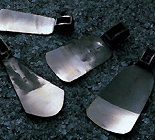

Total:131items
- Pottery & Porcelain (18)
- Lacquerware (4)
- Glasswork (2)
- Wood & Bamboo Work (19)
- Leather Work (1)
- Papermaking (13)
- Textile (20)
- Dyeing products (5)
- Masonry (1)
- Metal Work (11)
- Satsuma Suzuki: Satsuma Tinware
- Tosa Uchihamono: Tosa Blade
- Kaga Zougan: Kaga Inlay
- Akita Ginsen Zaiku: Akita Filigree
- Token: Japanese Sword
- Banshu-gama : Banshu Sickle
- Echigo-Sanjo Uchi Hamono: Echigo-Sanjo Blade
- Osaka Naniwa Suzuki: Pewter/Tin Ware
- Nakaniida-Uchihamono: Nakaniida Traditional Blade
- Higo-Tsuba
- Nokaji Hamono: Nokaji Blades
- Stationery (4)
- Livingware (3)
- Accessory (4)
- Toys & Entertainment (14)
- Interior (2)
- Other crafts (10)

 |
Main Production Site:Kochi |
 《Characteristics》
《Characteristics》Tosa Blade (Tosa is current Kochi Pref., West Japan) is superior for its sharpness, durability, and ease of maintenance. It is widely used in a variety of goods such as items specific to forestry and architecture, sickles and colters for agriculture, cooking knives, and outdoor knives.
The process of Tosa Blade manufacturing originated from techniques used to make Japanese swords. It is called "free forging of Tosa" because artisans can forge any figure of blades with only specifications of size and shape given by customers across the country.
Materials of Tosa Blade are Yasugi Speciality Steel and soft bare metals. Materials of different hardness are mixed, heated, and then thoroughly striken to make it straight. With the process manually performed until the last sharpening, artisans are able to make a one of a kind product which neither breaks nor bends.
[Traditional Craft Officialy Designated by Minister of Economy, Trade and Industry]
Source:Kochi Prefecture / Kochi Marugoto Net Office
Translation by: Miwa Odagiri, reviewed by Yoshiko Nagao

| Materials | Mainly Iron |
|---|---|
| Crafting Processes | 1. Steelmaking - Ironmaking
Produce steel and iron materials. 2. Forge welding Strike iron and steel heated in the hearth to merge. Put the hard steel between the soft iron to prevent the steel from breaking. 3. Forging - Molding Heat the forged materials in the hearth. After it has become evenly red from the heat, take out the material from the hearth and furnace. Mold quickly by hitting with a large high speed rotation hammering machine. This process requires proficient skill such as balancing and angling the strike. 4. Rough sharpening Make rough shape of hatchets and blades. Arrange into a balanced shape of hatchets by using clicker cutter press and grinder. 5. Daubing Daub natural mud on the blade evenly. 6. Quenching - Tempering [Quenching] Heat in the furnace. The temperature is higher than that of the forging process. Keep moving the blade to ensure even heating. This process is to make the hatchet hard. [Tempering] If hatchets are only hard, they can break if put pressure on. Therefore, re-heat again at a lower temperature to attain durability. After tempering naturally cool. 7. Straightening Strike the hatchets with a hammer and make straight. 8. Blade Edging - Sharpening Put an incisive edge on the blade then sharpen with care. 9. Attaching of the handle Attach a handle to the blade to finish |
| History | Kochi prefecture has one of the best warm climates with plentiful rain allowing for quality wood to grow and forestry to flourish.
At the same time, blades necessary for lumbering also has a long history. In the latter half of Kamakura period (12-14c), a group of Gorozaemon Yoshimitsu emigrated from Yamato (current Nara Pref., West Japan) and prospered until the end of Muromachi period(14-16c). In the war-torn era, they met the need for weapons. In 1590, there were 399 blacksmiths according to the Chosokabe regional examination note which was written based on examination of the whole of Tosa. In the Edo period (17-19c), production and quality of blades had fully flourished as Tosa Domain performed the securing of forest resources and development of new fields. Although the manufacturing processes have comparatively mechanized, skills from the Edo period are still carried on and Tosa is still one of the top three blade manufacturing area in Japan today. |
◆Exhibition / Showcase
Nishiyama Shokai
163, Hazama, Tosayamada-Cho, Kami City, Kochi Pref. 782-0004
(Japanese only)
Open: 9:00-17:00 during weekdays (Closed on weekends and holidays)
Assistance needed? For inquiries in English:
JTCO Contact Form
Your inquiries will be forwarded by JTCO in Japanese to the organization you wish to contact.



